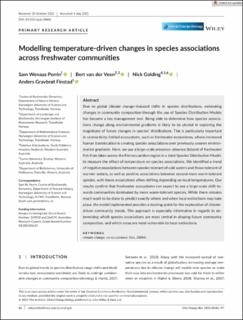| dc.contributor.author | Perrin, Sam | |
| dc.contributor.author | van der Veen, Bert | |
| dc.contributor.author | Golding, Nick | |
| dc.contributor.author | Finstad, Anders Gravbrøt | |
| dc.date.accessioned | 2022-03-10T14:44:23Z | |
| dc.date.available | 2022-03-10T14:44:23Z | |
| dc.date.created | 2021-11-01T14:51:33Z | |
| dc.date.issued | 2021 | |
| dc.identifier.citation | Global Change Biology. 2021, 28 (1), 86-97. | en_US |
| dc.identifier.issn | 1354-1013 | |
| dc.identifier.uri | https://hdl.handle.net/11250/2984373 | |
| dc.description.abstract | Due to global climate change–induced shifts in species distributions, estimating changes in community composition through the use of Species Distribution Models has become a key management tool. Being able to determine how species associations change along environmental gradients is likely to be pivotal in exploring the magnitude of future changes in species’ distributions. This is particularly important in connectivity-limited ecosystems, such as freshwater ecosystems, where increased human translocation is creating species associations over previously unseen environmental gradients. Here, we use a large-scale presence–absence dataset of freshwater fish from lakes across the Fennoscandian region in a Joint Species Distribution Model, to measure the effect of temperature on species associations. We identified a trend of negative associations between species tolerant of cold waters and those tolerant of warmer waters, as well as positive associations between several more warm-tolerant species, with these associations often shifting depending on local temperatures. Our results confirm that freshwater ecosystems can expect to see a large-scale shift towards communities dominated by more warm-tolerant species. While there remains much work to be done to predict exactly where and when local extinctions may take place, the model implemented provides a starting-point for the exploration of climate-driven community trends. This approach is especially informative in regards to determining which species associations are most central in shaping future community composition, and which areas are most vulnerable to local extinctions. | en_US |
| dc.language.iso | eng | en_US |
| dc.publisher | Wiley | en_US |
| dc.rights | Navngivelse-Ikkekommersiell 4.0 Internasjonal | * |
| dc.rights.uri | http://creativecommons.org/licenses/by-nc/4.0/deed.no | * |
| dc.title | Modelling temperature-driven changes in species associations across freshwater communities | en_US |
| dc.type | Peer reviewed | en_US |
| dc.type | Journal article | en_US |
| dc.description.version | publishedVersion | en_US |
| dc.source.pagenumber | 86-97 | en_US |
| dc.source.volume | 28 | en_US |
| dc.source.journal | Global Change Biology | en_US |
| dc.source.issue | 1 | en_US |
| dc.identifier.doi | 10.1111/gcb.15888 | |
| dc.identifier.cristin | 1950325 | |
| dc.relation.project | EC/H2020/642420 | en_US |
| dc.relation.project | Norges forskningsråd: 266574 | en_US |
| cristin.ispublished | true | |
| cristin.fulltext | original | |
| cristin.qualitycode | 2 | |

